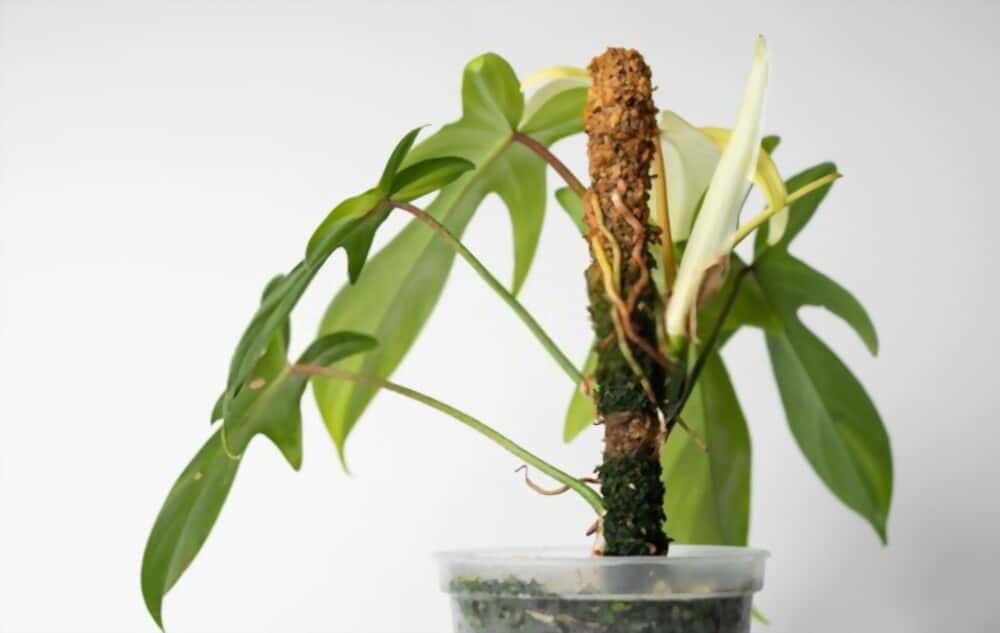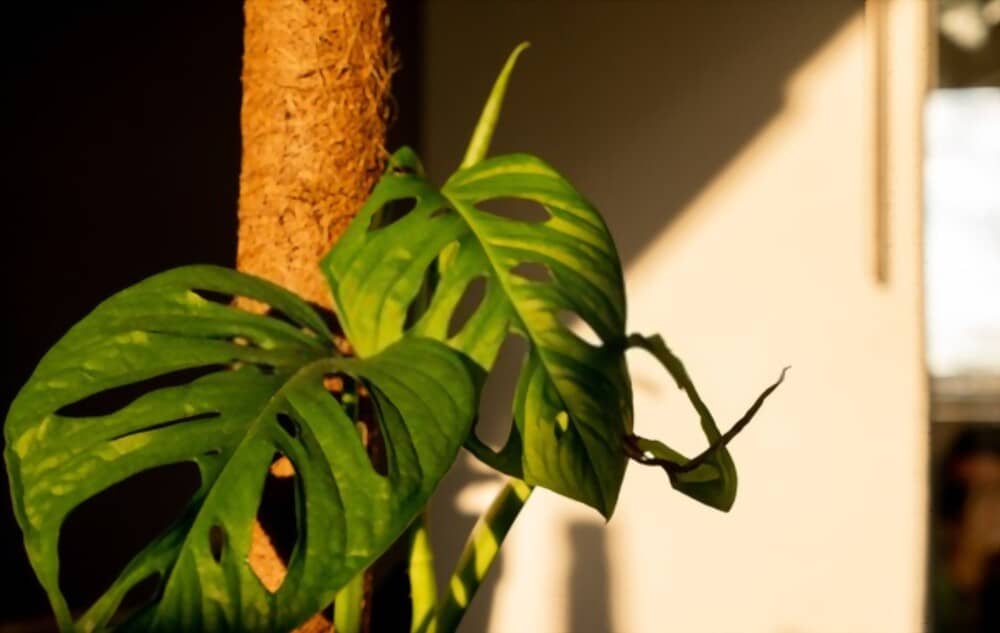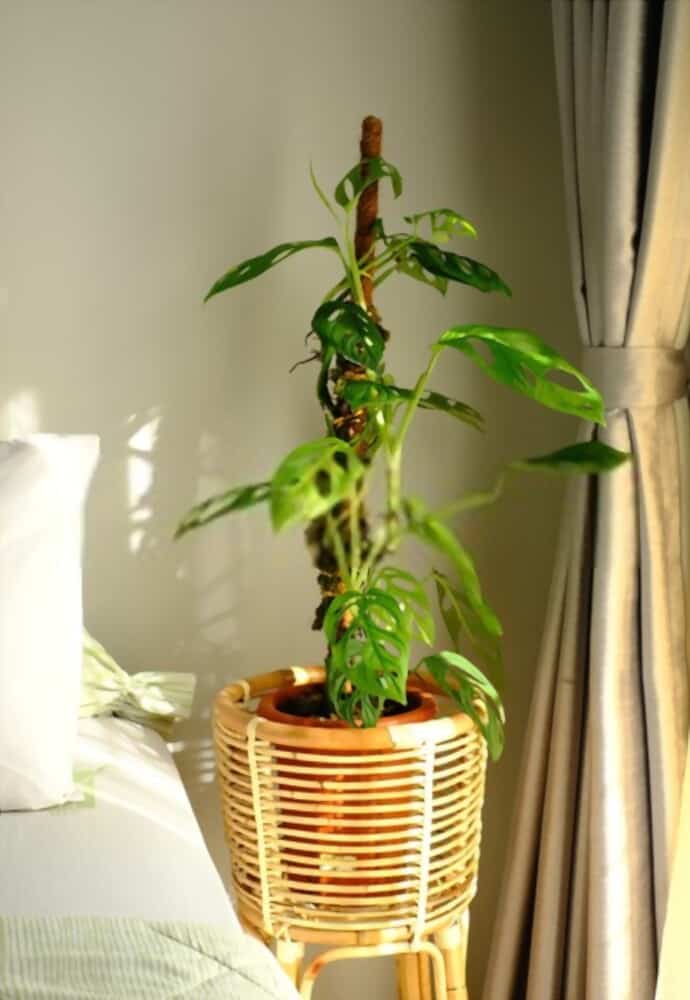
Tropical climbing plants can be supported easily by moss poles. However, because these plants enjoy humidity, there are a few things you can do to maintain moisture in a moss pole for them.
A water source must be used to gradually deliver water to the pole over time in order to maintain a moss pole moist. A continuous drip or wicking system can be used for this. The pole will also remain moist for longer periods of time if climatic variables like heat, wind, and humidity are maintained.
I’ll describe the various techniques I’ve personally used to maintain moisture in my moss pole when taking care of my Monstera adansonii and other climbing plants in this article.
If you want a moss pole that is both affordable and effective. Clicking here will take you there!
Table of Contents
How To Keep a Moss Pole Moist?
You may read our comprehensive post, which includes covers the many sorts of poles, how long they last, and how to create your own own, to learn more about how to utilize a moss pole for your plants.
For indoor plants with aerial roots that cling to surfaces, moss poles are fantastic solutions. Depending on the humidity needs of the plants in your garden, it’s vital to frequently moisten your moss pole.
Which method can you employ to constantly moisten a moss pole is the subject at hand.
I am aware that there are numerous ways to maintain moisture in a moss pole for the plants, but there are a few that I have personally tried over the years.
The following are some methods I’ve tried to keep moss on a stick moist:
1. Use a Wicking System
Maintaining the ideal balance of soil, water, and air is crucial for the proper and healthy growth of the plant in the pot.
A wicking system for watering satisfies the requirements for the most frequently advised way of watering for indoor plants.
To maintain the moisture level on a moss pole, employ a wicking method. A synthetic string is used in a Wick watering system, which uses it to absorb water and feed it to the plant.
The plants will benefit from a wick watering system by having consistently well-moisturized roots, a robust and developed root system, an abundance of leaves, and quick plant growth.
Check out these inexpensive but highly efficient wicking cords I’ve used. By clicking here, you may find it on Amazon.com!
2. Use a Bottle With 1 or 2 Fine Holes at the Top For Slow Drip
With the straightforward tool you already have at home, you can maintain a light mist on your moss pole. All you need for this technique is a plastic bottle and some tape or wire.
To create an automatic watering system, follow these steps:
- Look for a plastic bottle. In accordance with the size of your moss pole, you can use 1.5 liter, 2 liter, or even larger bottles.
- You just insert the needle into the cap after heating it over a flame.
- Ideally, three to four holes will do.
- Put the caps on the bottle after filling it with water.
- After that, fasten the water-filled bottle to the moss pole’s top.
- Try to secure it in a safe location.
- If you have any wire or a piece of tape, tighten it. It depends on the resources you have.
Control the External Environment To Keep The Pole Moist

When it comes to controlling the moisture content of a moss pole, external climatic factors like wind, heat from the sun, and humidity play a significant part in promoting the healthy growth of plants.
The moss pole is kept moist by these outside environmental variables. To aid the moss pole in holding onto more moisture, you might attempt a variety of techniques.
I’ll go over a few tactics that have been successful with my climbing plants.
3. Keep Your Moss Pole in a Cool Area Out of The Direct Sunlight
Plants require sunlight to survive. Plants cannot carry out the process of photosynthesis without sunshine, and therefore cannot produce food without photosynthesis.
But every kind of plant surface can lose water due to the sun’s heat.
Your moss pole will retain moisture better if you position the plants with it in a cool spot that is out of direct sunshine.
Additionally, you can keep plants in areas with fans and air conditioners.
The plant pots with moss poles should be kept in a shaded area of your house.
The best location for your plants would be where a sun line and a shadow line meet. Because sunlight is also essential for the development and health of plants.
4. Use a Humidifier
Humidity is the measure of how much water vapor is present in the atmosphere. You need to give tropical plants a bit additional humidity if you’re growing them indoors.
A humidifier warms the water until it evaporates into the air, at which point water vapor is emitted.
Long-term moisture retention in the moss pole can be aided by humidifiers. Use a humidifier to keep plants moist if you are growing a number of them on moss pole supports.
You may learn more about misting and humidity in my in-depth essay about misting plants.
NOTICE: Humidifiers should not be placed next to wooden furniture if they are being used indoors. The furniture’s wood construction is susceptible to harm from high humidity and water vapor infiltration.
Amazon’s Geniani portable humidifier offers the perfect level of ambient humidity for strong plant development. Clicking here will take you there.
5. Keep The Moss Pole in a Less Windy Area
If you are not prepared to deal with wind, it can cause a lot of harm to your plants. Being ready for windy environments will help your plants grow swiftly and stress-free.
The likelihood of having longer plants being damaged by the wind is higher than it is for shorter plants. The tall plants will have more difficulty in the wind. more so when lanky plants lean on poles for support.
A moss pole can readily lose moisture if it is left in a windy area. The moss poles can stay moisturized for a longer period of time if you keep them in a less windy region.
It is therefore advised to store the more delicate and taller plants, such as climbing plants, in a less windy region.
This will enable the moss pole’s moisture content to maintain a high level for longer.

What Does a Moss Pole Do?
In conclusion, moss poles are essential for helping climbing plants grow stronger and longer.
- With a moss pole, plant leaves will expand and become more vibrant.
- Such plants’ aerial roots will grow with support from moss poles.
- By growing upward, moss poles will assist climbing plants in obtaining more sunlight.
The plants benefit from moss poles in various ways. The main woody stem of the trees serves as support for plants with weak stems when they are growing in their natural habitat.
In order to absorb additional light and moisture from the environment, such plants’ aerial roots will expand upward along their trunks.
Climbing plants need an artificial environment that closely replicates their native environment when they are cultivated in pots, such as the Money plant, Monstera, and philodendrons.
These delicate plants are supported firmly by moss poles.
Did you know that you may make your own moss poles for a reasonable price? Visit our article on moss pole alternatives for 5 simple ways to make affordable support poles for your plants.
Why Should a Moss Pole Remain Moist?
Moss poles not only offer a solid base for the plant but also moisture to the plants.
The plants’ aerial roots will cling to the moss pole and receive water and nutrients from it.
The moss pole must be continually watered in order to stay damp.
Your plants will be able to take in and release water for their biological activities if your moss pole is consistently damp.
A humid climate will promote the quick growth of plants like aroids.
But it is advisable not to constantly moisten the moss pole if plants that dislike excessive humidity are developing in your garden.
Not all of the plants in your garden need a lot of humidity.
Even some plants appreciate extremely low humidity levels. Fungal illnesses can also be caused by excessive dampness.
– As your plant binds to the moss pole, you can remove the twine.
To maintain the moss pole moisture, place it in a cool, humid area or out of direct sunlight. You can also maintain the moss pole moisture with a humidifier. However, keep in mind that too much humidity or moisture can also form mold spores and damage your plants.
The aerial roots of the plants will get attached to the moss pole and they will get nutrients and water from them. Therefore, it is important to keep watering the moss pole to keep moist.
To maintain the moss pole moisture, place it in a cool, humid area or out of direct sunlight. You can also maintain the moss pole moisture with a humidifier. However, keep in mind that too much humidity or moisture can also form mold spores and damage your plants.
A moss pole that is left in a windy location may rapidly lose its moisture. The moss poles can stay moist for longer if you keep them in a less windy region.
